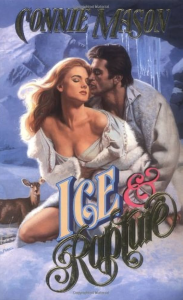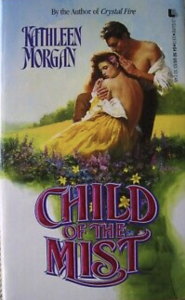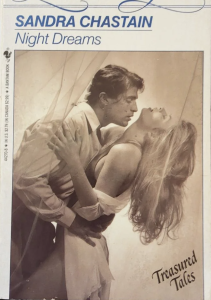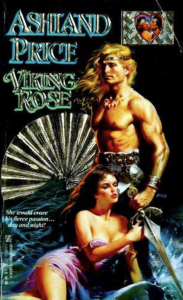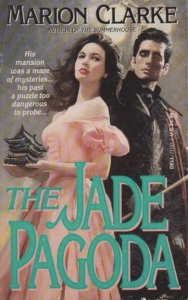Brushstrokes of Passion: Exploring Romance Novel Cover Art in 1993
By Diya Panjabi (2024)
Introduction
The image of the couple on romance novel covers has changed over time but remains a significant representation of intimacy and desire for female readers. In this paper, I will discuss how these images convey common notions of romance in early (specifically January) 1993, in a manner that is appealing to women. The main primary source I will be using is the January 1993 issue (#106) of Romantic Times magazine[1]. Romantic Times was a magazine created in July 1981 and published in New York until March 2002 that featured reviews, news, and recommendations regarding popular romance novels at the time. I will be discussing specific novels mentioned in this 1993 issue, such as Night Dreams by Sandra Chastain (1993)[2], The Fairest of Them All by Leanne Banks (1993)[3], Ice & Rapture by Connie Mason (1993)[4], Child of the Mist by Kathleen Morgan (1993)[5], The Jade Pagoda by Marion Clarke (late 1992)[6], and Viking Rose by Ashland Price (1993)[7]. First, I will discuss the positioning of the characters on the cover. Then, I will talk through the physical appearance and clothing of the characters.
Positioning of the Characters
With regard to the positioning of the characters on the cover, the main pattern I noticed is that the man and woman are typically embracing in one of two ways. First, the man’s arms are around the woman, such as in the historical romance Ice & Rapture by Connie Mason (1993) and historical romance Child of the Mist (1993) by Kathleen Morgan:
On the cover of Ice and Rapture, the female and male characters’ lips are nearly touching, and his arms are embracing her, their bodies against each other[8]. On the cover of Child of the Mist, the man and woman’s heads are again very close together, with one of the man’s hands touching the woman’s hair and the other on her revealed body in an intimate gesture[9]. Both of these embraces display much physical closeness and tenderness.
In the second alternative, the man is holding the woman up and the woman is hanging onto the man, while they are gazing into each other’s eyes or the woman is tilting her head back, held up almost exclusively by the man’s arms, and once again their lips only separated by a few inches. This can be seen specifically in the contemporary romance The Fairest of Them All by Leanne Banks (1993)[10] and Night Dreams by Sandra Chastain (1993)[11]:
According to the journal article “Evolutionary and Sociocultural Themes in Cover Art on Harlequin Romance Novels: A Temporal Analysis” by Maryanne L. Fisher and Tami Meredith, in the 1990s “the couple [is] in the center of the cover as the focus, usually touching, often embracing, and, in many instances, close to kissing,”[12] as seen above. Fisher and Meredith interpret this as appealing to and reflecting the female desire for “increased intimacy”[13] in a relationship compared to years past. Their observation that the couple is usually the center of focus on romance cover novels is also consistent with those shown in the Romantic Times January 1993 issue[14]. Not only is the couple typically depicted in the center of the cover, they take up the entire space and everything around them is merely background. Keeping the image of an intimate couple as the main focus on romance novel covers helps clearly convey the romantic content of the novel to the readers. It is also important to note that in all three cases, the man appears to be gazing at the woman. According to the journal article “The Look of Love: Gaze Shifts and Person Perception” by Malia F. Mason and Elizabeth P. Tatkow, “gaze direction reveals the identity and status of the current objects of attention,”[15] and that gazing with intense eye contact is a “nonverbal language”[16] of love. The repeated theme on these covers of the man gazing at the woman further reflects the female desire to be the object of the male’s attention and interest in romantic settings. There are, however, two outliers regarding this pattern. The first outlier is Viking Rose by Ashland Prince[17], which is said to be a historical viking romance:
Here, rather than the woman and man embracing, she is lying beside him on the ground (propped up on her hand), and he is standing tall. A potential explanation could be the fact that this is a viking romance rather than a typical historical romance or contemporary romance, but it is important to note that we cannot assume this is the exact reason. The male character standing tall above the woman could be a show of dominance, with the woman lying below him potentially being representative of submission. This would fall in line with the viking romance hypothesis, but it is important to keep in mind that these are merely theories and that we would have to analyze more viking romance novel covers from January 1993 in order to shift this theory to assertion. Another outlier can be seen in the gothic romance titled The Jade Pagoda by Marion Clarke[18]:
In the cover of this novel, both the male and female are standing tall, back to back. However, even in this case, the man is still gazing at the woman. Perhaps the reason for their unique positioning is due to the fact that this is more of a suspenseful romance compared to the others, depicting a story about a woman who finds something strange in the home she is decorating for the man on the cover, but we cannot assume that this is true without confirmation from the author and/or cover artist. Overall, the positioning of the characters on the cover of romance novels should not be overlooked. It can convey an immense amount of intimacy and act as a window into the demeanor and dominance or submissiveness of the characters.
Physical Appearance and Clothing
The physical appearance and clothing of the characters are also a large component to romance novel covers. In Viking Rose by Ashland Prince (1993)[19], The Fairest of Them All by Leanne Banks (1993)[20], and historical romance novel Child of the Mist by Kathleen Morgan (1993)[21], the men are all shirtless or have their shirt almost completely off, revealing a hairless and muscular chest. The men’s arms also appear to be very muscular, and are devoid of body hair as well. This observation is not merely a coincidence; it represents what romance readers in early 1993 seemed to find appealing in a male protagonist. According to the book Reading the Romance: Women, Patriarchy, and Popular Literature by Janice A. Radway, the male body in the popular romance novel should be a site of “spectacular masculinity”[22]. Radway also notes that “every aspect of [the hero’s] being, whether his body, his face, or his general demeanor is informed by his maleness”[23]. This further helps to explain why the man tends to be taller than the woman, and why he is generally seen as supporting or holding her. It is also important to note that when masculinity is mentioned, I am referring to what was construed as “masculine” at the time. The journal article “The Purity of his Maleness: Masculinity in Popular Romance Novels” by Jonathan A. Allen also claims that a man’s upper body must appear “slim toned, and muscular,” and “must be that one is ‘cut’ and ‘chiseled’, [appearing] strong and powerful”[24]. These qualities are visibly evident in the novels mentioned above, especially Viking Rose[25], where readers can clearly see the muscle striations on the man’s shoulders and muscular arms. These qualities help represent what women wanted in the male protagonist at this time. The authors and publishers wanted to cater to women’s desires by creating romantic and appealing novel covers in order to make women more likely to want to read (and therefore buy) them. Allen’s article further supports this idea, claiming that the “ideology of masculinity [is] worthy of consideration, particularly because the genre is, by and large, written by women for women”[26]. This further perpetuates the idea that the men depicted on the cover of these novels are portrayals of what women wanted to see in romance in early 1993. Another common trend in physical appearance on the covers of the romance novels featured in the January 1993 issue of Romantic Times is that the woman’s hair typically appears to be blowing in the air or hanging down behind her head[27]. This is very clearly seen in The Fairest of Them All[28], Night Dreams[29], Viking Rose[30], Ice & Rapture[31], Child of the Mist[32], and The Jade Pagoda[33]. Another pattern that I observed is that the woman tends to have long, flowy hair with the exception of The Fairest of Them All and The Jade Pagoda. However, even in these two novels, the woman’s hair is still hanging down behind her or seemingly billowing in the air. None of the covers featured in this issue depicted a woman with her hair up. A potential reason for this could be that flowy hair enhances the femininity (more accurately what was construed as femininity at this time) of the woman on the cover, but it is not something we can say for certain with the evidence we have here. Another common element that I found in all of the featured novels in the January 1993 issue of Romantic Times is that the woman is wearing a garment that falls off of her shoulders, leaving her collarbone and neck exposed[34]. This extra skin being shown adds to both the physical intimacy of the covers, which consequently makes them appear more romantic. Furthermore, in covers such as Ice & Rapture and Viking Rose, the clothing resembles drapery (one piece of cloth that is draped around the body) more than an actual dress or outfit, making these covers appear a bit more riské (almost as if they are creating the illusion of wearing bedsheets). Overall, the way the male body is depicted, the style of the hair shown, and the type of clothing the woman wears are all elements that give insight into the notions of romance in early 1993.
Conclusion
In conclusion, the analysis of the elements that went into the romance novel covers contained in the January 1993 issue of the Romantic Times reveals intriguing insights into the common notions of romance in that era[35]. Through analyzing the positioning of the characters, as well as their physical traits and the clothing they wore, a nuanced portrayal of intimacy, romance, and desire is revealed. Utilizing this strategic character placement and physical attributes and attire, artists were able to create images that resonated with what romance readers at the time found appealing.
Footnotes
[1] Bromberg, Toby, Melinda Helfer, Kathe Robin, and Jill Smith, eds. Romantic Times no. 106, January 1993.
[2] Chastain, Sandra. Night Dreams. New York: Bantam Books, 1993.
[3] Banks, Leanne. The Fairest of Them All. New York: Bantam Books, 1993.
[4] Mason, Connie. Ice & Rapture. New York: Leisure Books, 1999.
[5] Morgan, Kathleen. Child of the Mist. Grand Rapids, MI: F.H. Revell, 2005.
[6] Clarke, Marion. The Jade Pagoda. New York: A Dell Book, 1992.
[7] Price, Ashland. Viking Rose. New York, NY: Kensington, 1993.
[8] Mason, Ice & Rapture
[9] Morgan, Child of the Mist
[10] Banks, Leanne. The Fairest of Them All
[11] Chastain, Night Dreams
[12] Fisher, Maryanne L. and Tami Meredith. “Evolutionary and Sociocultural Themes in Cover Art on Harlequin Romance Novels: A Temporal Analysis.” Evolutionary Behavioral Sciences 16, no. 2 (2022), 9
[13] Fisher and Meredith, “Evolutionary and Sociocultural Themes in Cover Art on Harlequin Romance Novels: A Temporal Analysis,” 9
[14] Bromberg, Toby, Melinda Helfer, Kathe Robin, and Jill Smith, eds. Romantic Times no. 106, January 1993.
[15] Mason, Malia F., Elizabeth P. Tatkow, and C. Neil Macrae. “The Look of Love: Gaze Shifts and Person Perception.” Psychological Science 16, no. 3 (2005): http://www.jstor.org/stable/40064207, 2
[16] Mason, Tatkow, Macrae, “The Look of Love: Gaze Shifts and Person Perception,” 2
[17] Price, Viking Rose
[18] Clarke, The Jade Pagoda
[19] Price, Viking Rose
[20] Banks, The Fairest of Them All
[21] Morgan, Child of the Mist
[22] Radway, Janice A.. Reading the Romance : Women, Patriarchy, and Popular Literature, University of North Carolina Press, 1991. ProQuest Ebook Central, https://ebookcentral.proquest.com/lib/duke/detail.action?docID=880363, 128
[23] Radway, Reading the Romance : Women, Patriarchy, and Popular Literature, 128
[24] Allan, Jonathan A. “The purity of his maleness: masculinity in popular romance novels.” The Journal of Men’s Studies 24, no. 1 (2016): 24+. Gale Academic OneFile (accessed April 12, 2024). https://link.gale.com/apps/doc/A445018050/AONE?u=duke_perkins&sid=summon&xid=41ab060a, 5
[25] Price, Viking Rose
[26] Allan, “The purity of his maleness: masculinity in popular romance novels,” 1
[27] Bromberg, Toby, Melinda Helfer, Kathe Robin, and Jill Smith, eds. Romantic Times no. 106, January 1993.
[28] Banks, The Fairest of Them All
[29] Chastain, Night Dreams
[30] Price, Viking Rose
[31] Mason, Ice & Rapture
[32] Morgan, Child of the Mist
[33] Clarke, The Jade Pagoda
[34] Bromberg, Toby, Melinda Helfer, Kathe Robin, and Jill Smith, eds. Romantic Times no. 106, January 1993.
[35] Bromberg, Toby, Melinda Helfer, Kathe Robin, and Jill Smith, eds. Romantic Times no. 106, January 1993.
Bibliography
Allan, Jonathan A. “The purity of his maleness: masculinity in popular romance novels.” The Journal of Men’s Studies 24, no. 1 (2016): 24+. Gale Academic OneFile (accessed April 12, 2024). https://link.gale.com/apps/doc/A445018050/AONE?u=duke_perkins&sid=summon&xid=41ab060a.
Banks, Leanne. The Fairest of Them All. New York: Bantam Books, 1993.
Bromberg, Toby, Melinda Helfer, Kathe Robin, and Jill Smith, eds. Romantic Times no. 106, January 1993.
Clarke, Marion. The Jade Pagoda. New York: A Dell Book, 1992.
Chastain, Sandra. Night dreams. New York: Bantam Books, 1993.
Fisher, Maryanne L. and Tami Meredith. “Evolutionary and Sociocultural Themes in Cover Art on Harlequin Romance Novels: A Temporal Analysis.” Evolutionary Behavioral Sciences 16, no. 2 (2022): 157-175.
Mason, Connie. Ice & rapture. New York: Leisure Books, 1999.
Mason, Malia F., Elizabeth P. Tatkow, and C. Neil Macrae. “The Look of Love: Gaze Shifts and Person Perception.” Psychological Science 16, no. 3 (2005): 236–39. http://www.jstor.org/stable/40064207.
Morgan, Kathleen. Child of the mist. Grand Rapids, MI: F.H. Revell, 2005.
Price, Ashland. Viking Rose. New York, NY: Kensington, 1993.
Radway, Janice A.. Reading the Romance : Women, Patriarchy, and Popular Literature, University of North Carolina Press, 1991. ProQuest Ebook Central, https://ebookcentral.proquest.com/lib/duke/detail.action?docID=880363
